
|
| |
1910–1924 | 1925–1926 | 1927–1930 | 1931–1943 | MORE RECENT
HOUDINI MADE HIMSELF THE MASTER MAGICIAN Began as a Sideshow Artist and First Won Recognition in Europe—He Carried on a Rigorous Campaign Against Exponents of the Supernatural By JOHN B. KENNEDY
Nature had endowed him perfectly for his role. His muscular frame had a solidness that deceived, for in reality every joint was pliable, every tissue fluent. He was a practiced contortionist and kept in training through constant practice. He used to weave ropes in scores of involutions with his restless hands and arms before every performance. Houdini had the head and face of a poet or priest: indeed, he was the son of a rabbi—Mayer Samuel Weiss, who migrated from Poland to Appleton, Wis. The round, well-tufted head, with its ample forehead, fine-lined brow, gray eyes speckled with yellow, and sharp nose, gave him a scholarly cast of countenance that became ascetic in his later years, bringing an almost incongruous touch to his more athletic stunts. Mentally he was gifted with acute powers of induction, as every inventive mind must be. He was not a formally educated man. His diction was faulty and even the accent of his speech was at times uncultivated. But he had whiplike resourcefulness allied with physical and moral courage that captured the imagination. A Self-Made Magician His career was self-made, without advantage of apprenticeship to any of the so-called masters of the necromantic arts. In a recent interview with the writer he said he had launched himself into the world as a hobo wizard, traveling anywhere he could land with a circus or an organization of side-shows and doing anything that came to his hands or into his head—from acrobatics to clowning—to stir wonder and gain applause.
Houdini’s earlier experience in a locksmith’s shop at Appleton, where he had worked as a boy, turned his mind to the technique of escape; and the popularity of the Davenport brothers’ exhibitions impressed him with the profitable possibilities of this form of entertainment. For several years he was content to jog along with the primer tricks of magic; but all the time he was studying—not from books, for van space was precious, and when an adventurer rode trains hobo-fashion he could take little baggage. Houdini made it a practice to hunt out locksmiths in every town visited. Often he would obtain employment for a month or two with a locksmith. By the time he had decided to specialize in sensational escapes he had mastered the art of mechanical restraint. Other things he learned—the crudities and refinements of chicanery and charlatanism practiced by the shell-game men, fakers, medicine merchants and psycho-swindlers. This intimacy with the seamy side of the show business filled Houdini with disgust and raised him above the common ruck of illusionists. Instead of remaining merely an adept charlatan he became in time something of a scientist. The “Handcuff King” Emerges
At Coffeyville, Kan., when in his twenties, Houdini first burst into legitimate news by breaking from handcuffs affixed by a sheriff for some political indiscretion. Later he joined forces with an Ohio dentist who had a passion for showmanship and the two had some profitable ventures. But it was not until he had broken into cable news with astonishing exploits abroad that his native country acknowledged Houdini’s true eminence. Just as he amazed Washinton by effecting an easy escape from the cell that had imprisoned the murderer of President Garfield, so he amazed England by breaking out of the stoutest locks and chains that the best binders from Scotland Yard and Brixton Prison could encase him in. He made Holland gasp by having celebrated basket-makers weave him in a container from which he escaped without splitting a fibre. In Berlin he fooled the wardens of the great castle prison by reposing manacled in a dungeon at 8 in the morning, only to salute a copy on the corner ten minutes later. These sensational exploits were repeated endlessly. The little thick-set contortionist thrived on them. He hung head downward, straight-jacketed, handcuffed, iron-ankled, from high buildings, at home and abroad, and wriggled free in the sight of neck-craning crowds. He could break any bonds, anywhere, and set a time-limit for his escape after an apparently perfunctory examination of ropes or chains or handcuffs. Chiefs of police acknowledged his skill. Took His Life in His Hands
In California he permitted himself to be buried beneath six feet of soil and mad his way out a very scared magician, although his poker face never betrayed internal wincing. That, he told me, was the narrowest escape he ever had. It led him to practice his trick of “high breathing” to such a state of perfection that he was later able to expose a reputed Egyptian fakir who could remain buried alive for an hour in a casket under water—ostensibly by supernatural power. There were other narrow escapes, such as upon the first occasion of his being buried, manacled and boxed, form a boar in the East River. Resourcefulness, however, always came to the rescue. These hair-breadth escapes improved his technique; but by some strange contradiction in his character they promoted boldness rather than caution. He went always after bigger and better escapes—and made them. His greatest achievements of this sort were undoubtedly his paper-bag and ice-cake breakaways. In the former he came in less than a minute’s time from behind a screen, where he had been placed wrapped and tied and sealed in brown paper by bag-factory girls. The strings and seals were left intact. In the other trick he burst form a block of ice frozen about his body. This was mysteriously accomplished by depressing his periphery as a prelude to dynamic expansion. Houdini Turns Crusader
After making fame and fortune through years of this most hazardous and uninsurable livelihood, Houdini turned crusader, entering the final and most fruitful stage of his career. He remained the entertainer, for he relished his large earnings as any man does who has risen to four figures weekly and beyond; but he never exploited himself beyond the realms of entertainment save in what he considered the interests of science. Accumulating an amazing library of magic and autographs (he had the finest collection of Ingersoll holographs extant), he steeped himself in dramatic and occult lore. Curiously, he made an ambitious exposé of the very man whose name he appropriated, Robert Houdin. It took the form of a book on what he called the piracles [sic] and fraud of Houdin. Yet his most insistent hypothesis was that all magic is faking, which makes his condemnation of Houdin all the more anomalous. There is no trick of the recognized masters, from Cagliostro’s magic mirror to Kellar’s Hindoo lamp and Maskelyne and Devant’s Haunted Window, that Houdini did not succeed in fathoming and, when he liked, duplicating. He “vanished” elephants, and achieved so high a mark in the art of misdirection that he could switch cards in a card trick right under a spectator’s nose. This versatility was the fruit of his enthusiasm for plaudits. No music was sweeter to his ears than the whispered wonder of children or the rapturous hand-clappings of crowds of baffled adults. Houdini lived for this more than for money. His New York ménage was without display. He ate the simplest food, did not drink, never smoked. His most priceless possession, his library, acquired as a result of great patience and even privation, has been willed to the public. No Believer in Supernatural
Houdini asserted that there is, and can be no such thing as suspension of natural laws; that everything done by fakir, medium, clairvoyant, horologist, palmist can be explained in terms of physics, chemistry and psychology manipulated with agility. One day a skeptic called on him. Houdini read this man’s hand, prognosticated his future and pronounced his past from a mere reading of his face, having only been told the day of his birth. This was done with a vividness and general accuracy that astonished the subject, who had lately paid $20 for a reading by a sky-gazer. His “Margery” Challenge Exposure of Argamasilla’s “mental reading” tricks (explained by Houdini as mere ocular dexterity) was an item in his career as stormy petrel. It helped stamp him the outspoken enemy of pretense. He preached the doctrine that tricks were meant to bewilder and amuse, not to exploit and victimize under the false shadow of religion. He carried on a campaign against spiritists. The famous “Margery” test case excited him more than did anything else. He challenged Conan Doyle and Sir Oliver Lodge and branded as fraud the “witch of Beacon Hill.” He offered to give $10,000 to any one who could produce any spiritistic phenomenon or manifestation that he could not, within a reasonable time, duplicate mechanically. Houdini believed that vast evil was done by pretenders to the occult. Houdini took great pride in the recognition bestowed by institutions of learning and was delighted when the faculty of a large Catholic university invited him to lecture before the student body.
“I want it to be my mission in life to expose fraud,” he used to say. “I am abused, I am threatened. When I die my enemies will credit and say that it is punishment for defying the occult powers. But while I have breath and ingenuity both will be used to unmask preying fakers, fortune-tellers, diabolists, and spirit-mongers. They are worse than patent medicines. They are positively poison.” Some man of equal physical elasticity and mental acumen may one day hit upon the same methods and do the same marvels to beguile a younger generation. Houdini’s successor, if there is one, will delude our descendants as Houdini fooled us. This successor will be a blessed newcomer indeed if he brings to the world what Houdini brought—courage as well as cleverness and an active hatred of the false. This article is reproduced here only for educational purposes. Please do not copy the text or accompanying images for commercial use.
|
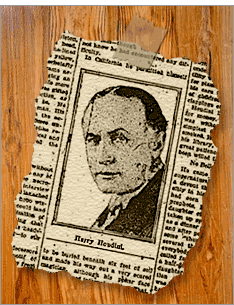 Houdini, who died a few days ago, will stand equal in renown with Hermann, Kellar, Robert Houdin (the man whose name he borrowed), Cagliostro and Pinetti. Houdini soared even higher than did these other magicians, for he stepped out of the old tradition of gas footlights to face in broad daylight a public leaping to sophistication, if not to knowledge, in physics and chemistry.
Houdini, who died a few days ago, will stand equal in renown with Hermann, Kellar, Robert Houdin (the man whose name he borrowed), Cagliostro and Pinetti. Houdini soared even higher than did these other magicians, for he stepped out of the old tradition of gas footlights to face in broad daylight a public leaping to sophistication, if not to knowledge, in physics and chemistry.
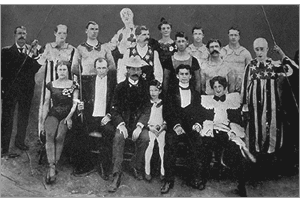 Even in rural circuses predecessors had introduced the escape motif of wizardry, extricating themselves from ropes and gyves. The Davenport brothers, then capturing the credulous by thousands, made a specialty of bond breaking, employing the simplest of tricks—the hidden slip-knot—to baffle sturdy Sheriffs and “gentlemen from the audience.” An obscure German juggler had made a specialty of divesting himself of straitjackets imposed according to the best madhouse methods.
Even in rural circuses predecessors had introduced the escape motif of wizardry, extricating themselves from ropes and gyves. The Davenport brothers, then capturing the credulous by thousands, made a specialty of bond breaking, employing the simplest of tricks—the hidden slip-knot—to baffle sturdy Sheriffs and “gentlemen from the audience.” An obscure German juggler had made a specialty of divesting himself of straitjackets imposed according to the best madhouse methods.
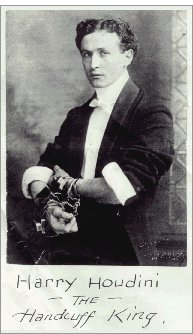 A story is told of his first emergence as the “Handcuff King.” It is related that the queer folk of a traveling circus were rounded in a country hoosegow for failure to pay board or what-not—the rubber-man, the bearded lady, the living skeleton, the fat girl and Houdini. At nightfall Houdini went to work on the cell locks and released his colleagues and himself.
A story is told of his first emergence as the “Handcuff King.” It is related that the queer folk of a traveling circus were rounded in a country hoosegow for failure to pay board or what-not—the rubber-man, the bearded lady, the living skeleton, the fat girl and Houdini. At nightfall Houdini went to work on the cell locks and released his colleagues and himself.
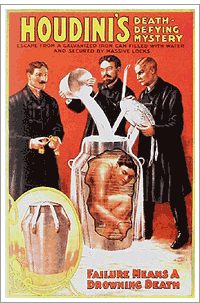 He once said that this deliberate quest for notoriety placed his life in jeopardy on several occasions. In Chelsea, England, they bound him to the muzzle of a cannon, loaded and primed by a time-clock to go off within 15 minutes. It was a wager-challenge to which the authorities objected. But Houdini went through and won. In Leeds he first performed his then novel stunt of permitting himself to be sealed in a cask of ale and working his way out. On this particular occasion he nearly missed emerging, for the ale was powerful. He was overcome by the fumes, and only quick work on the part of his faithful assistant, James Collins, rescued him—though the audience did not know he had encountered any difficulty.
He once said that this deliberate quest for notoriety placed his life in jeopardy on several occasions. In Chelsea, England, they bound him to the muzzle of a cannon, loaded and primed by a time-clock to go off within 15 minutes. It was a wager-challenge to which the authorities objected. But Houdini went through and won. In Leeds he first performed his then novel stunt of permitting himself to be sealed in a cask of ale and working his way out. On this particular occasion he nearly missed emerging, for the ale was powerful. He was overcome by the fumes, and only quick work on the part of his faithful assistant, James Collins, rescued him—though the audience did not know he had encountered any difficulty.
 No man before him had seemed so boldly and openly, so thrillingly to defy natural laws. One or two inept contemporaries tried to duplicate his tricks, but with disaster. The relatives of a certain piano-mover are still wondering what happened to him after he attempted a “Houdini” in a pacing case dumped into a river in the Middle West. An Austrian hero who tried to head-downward, straight-jacket escape from a six-story building, discovered for science, if not for himself, that the skull fractures more severely when dropped from a height of six stories than when dropped from a height of five.
No man before him had seemed so boldly and openly, so thrillingly to defy natural laws. One or two inept contemporaries tried to duplicate his tricks, but with disaster. The relatives of a certain piano-mover are still wondering what happened to him after he attempted a “Houdini” in a pacing case dumped into a river in the Middle West. An Austrian hero who tried to head-downward, straight-jacket escape from a six-story building, discovered for science, if not for himself, that the skull fractures more severely when dropped from a height of six stories than when dropped from a height of five.
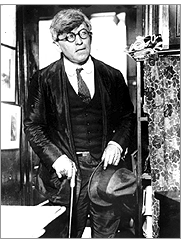 He came to detest claims to the supernatural, although he was at heart a devout theist. At some time, possibly in his own circle of friends, he had seen havoc wrought by false prophets. I told him once that the daughter of a distinguished man had taken up spiritism. He went with me as a dinner guest to this man’s house, and after performing his rather gruesome “thumb” trick, in which he severed that digit in plain view of everybody and then restored it, he called for a tall glass, a napkin and a half-dollar. With these he gave the daughter of the house a demonstration of “psychic phenomena” that was neat tete-a-tete conjuring. At her call the coin walked up the sides of the glass and tapped thereon in answer to supposed mental queries. The girl was impressed.
He came to detest claims to the supernatural, although he was at heart a devout theist. At some time, possibly in his own circle of friends, he had seen havoc wrought by false prophets. I told him once that the daughter of a distinguished man had taken up spiritism. He went with me as a dinner guest to this man’s house, and after performing his rather gruesome “thumb” trick, in which he severed that digit in plain view of everybody and then restored it, he called for a tall glass, a napkin and a half-dollar. With these he gave the daughter of the house a demonstration of “psychic phenomena” that was neat tete-a-tete conjuring. At her call the coin walked up the sides of the glass and tapped thereon in answer to supposed mental queries. The girl was impressed.
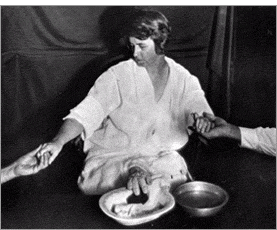 At heart and in essence he was a scientist. Before emulating Rahman Bey’s “buried alive” act in the Shelton Hotel swimming pool, Houdini practiced his feat at the offices of a casket company. He contemplated having a glass-faced casket made so that any audience could watch him remain “buried alive” in a sealed coffin. He pointed out the scientific value of his conserved breathing in its application to submarine sailors and workers. One of his earliest inventions was a
At heart and in essence he was a scientist. Before emulating Rahman Bey’s “buried alive” act in the Shelton Hotel swimming pool, Houdini practiced his feat at the offices of a casket company. He contemplated having a glass-faced casket made so that any audience could watch him remain “buried alive” in a sealed coffin. He pointed out the scientific value of his conserved breathing in its application to submarine sailors and workers. One of his earliest inventions was a